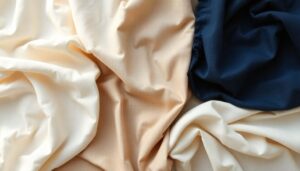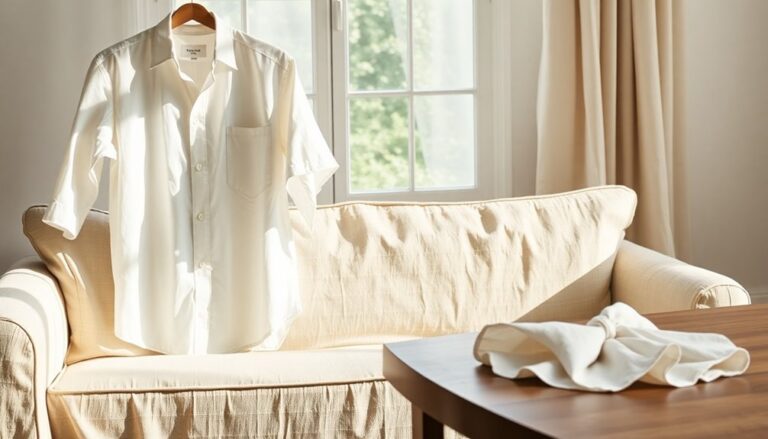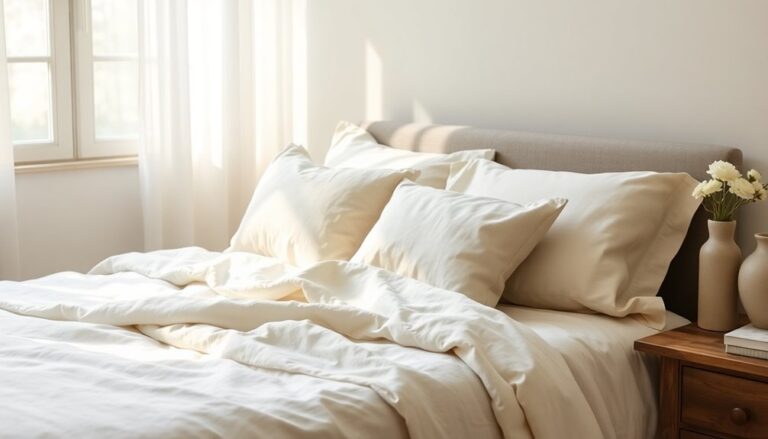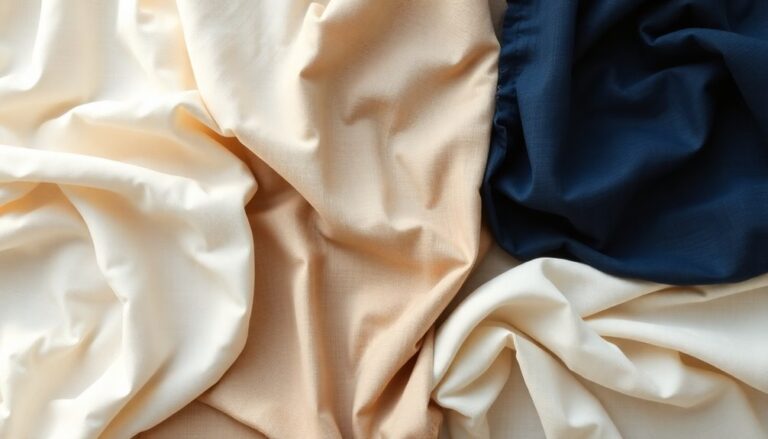For those with allergies, the best bedding includes hypoallergenic sheets, pillows, comforters, and mattress protectors. Materials like bamboo and microfiber resist dust mites and mold, creating a healthier sleep environment. Natural fibers like cotton and wool are likewise beneficial, though they may require more maintenance. Furthermore, mattress protectors can provide a crucial barrier against allergens. By following proper maintenance strategies, allergy sufferers can improve their sleep quality markedly. Discover more about maintaining an allergen-free bedroom setup. Regularly washing bedding in hot water and using a HEPA vacuum on mattresses and carpets can further reduce allergen buildup. The best bedding for allergies should also be free from harsh chemicals and dyes that could trigger sensitivities. Investing in high-quality, tightly woven fabrics can enhance protection against allergens, ensuring a more restful sleep.
Article Highlights
- Choose hypoallergenic sheets made from bamboo or microfiber to resist dust mites and mold, enhancing comfort and cleanliness.
- Opt for pillows made from natural fibers like cotton or wool, or synthetic options that are specifically labeled as hypoallergenic.
- Select comforters and duvets made from microfiber, cotton, or synthetic fills, ensuring they are machine washable for easy maintenance.
- Use mattress protectors constructed from hypoallergenic materials to prevent dust mite exposure and maintain a dry, mold-free environment.
- Regularly wash bedding in hot water and keep humidity levels low to effectively eliminate allergens and improve sleep quality.
Understanding Allergens in Bedding

Although many people may not realize it, bedding can harbor a variety of allergens that affect sleep quality and overall health. Common allergen sources include dust mites, mold, and pet dander, which thrive in various bedding types such as mattresses, pillows, and sheets. Dust mites, in particular, are microscopic creatures that feed on dead skin cells, finding a perfect home in bedding materials. Furthermore, certain fabrics may retain moisture, promoting mold growth. This accumulation of allergens can lead to respiratory issues, skin irritations, and disrupted sleep. Consequently, comprehending these allergen sources is essential for anyone looking to improve their sleep environment. By choosing appropriate bedding types and maintaining cleanliness, individuals can greatly reduce allergens and improve their overall wellness.
Hypoallergenic Sheets: Materials to Consider
When selecting sheets for allergy sufferers, it is crucial to take into account materials that minimize allergen accumulation and irritation. Bamboo sheets are a popular choice, as they're naturally resistant to dust mites and mold. Their breathable fabric helps regulate temperature, making them comfortable for all seasons. Conversely, microfiber options provide a tightly woven structure that prevents allergens from settling in the fibers. This material is likewise easy to clean and quick-drying, which is beneficial for maintaining hygiene. In the end, both bamboo and microfiber sheets offer hypoallergenic properties, ensuring a more restful sleep for those sensitive to allergens. Choosing the right material can greatly improve comfort and reduce allergy-related disturbances during the night.
Choosing the Right Pillows for Allergy Relief

When selecting pillows for allergy relief, material choice plays an essential role. Hypoallergenic options can greatly reduce exposure to allergens, making it easier to breathe at night. Regular maintenance, like washing and replacing pillows, likewise helps keep allergens at bay.
Material Matters
Selecting the right pillow can greatly impact allergy sufferers' comfort and quality of sleep. The materials used in pillows can either exacerbate or alleviate allergy triggers. When assessing bedding choices, it's crucial to take into account the following factors:
- Natural Fibers: Cotton and wool are less likely to harbor allergens.
- Synthetic Options: Polyester might be hypoallergenic but can trap dust.
- Memory Foam: Often resistant to dust mites, but check for additives.
- Latex: Naturally antimicrobial and resistant to mold.
- Washability: Pillows that can be easily washed help reduce allergen accumulation.
Hypoallergenic Options
Finding the right pillows can make a significant difference for those dealing with allergies. When selecting pillows, it's vital to opt for hypoallergenic options designed to reduce allergens. Look for organic bedding materials free from harmful chemicals, as these can irritate sensitive individuals. Moreover, pillows that are dust mite resistant are critical; they help prevent the accumulation of dust mites, a common allergen. Materials such as natural latex or polyester fill often provide a safer alternative, as they resist allergens during comfort. It's also advantageous to choose pillows with removable, washable covers to maintain a clean sleeping environment. By making informed choices, allergy sufferers can enjoy restful nights without the constant worry of allergic reactions.
Regular Maintenance Tips
Although selecting the right pillows is crucial for allergy relief, regular maintenance plays an equally important role in ensuring a healthy sleep environment. Proper bedding cleaning and dust mite prevention are key to minimizing allergens. Here are some tips to maintain pillow hygiene:
- Wash pillowcases weekly in hot water.
- Replace pillows every 1-2 years to avoid dust accumulation.
- Use allergen-proof pillow covers to protect from dust mites.
- Air out pillows in the sun monthly to reduce moisture and allergens.
- Vacuum your bedroom regularly, focusing on areas around the bed.
Comforters and Duvets: Best Options for Allergies

In relation to selecting comforters and duvets for allergy sufferers, awareness of materials and construction is vital. Hypoallergenic comforter materials, such as microfiber, cotton, and synthetic fills, are often preferred as they resist dust mites and allergens. Natural options, like silk or bamboo, can likewise be beneficial, but they may require more diligent duvet care. It's imperative to choose items that are machine washable, allowing for easy cleaning and maintenance. Regular washing helps eliminate allergens that could trigger reactions. Moreover, selecting tightly woven fabrics can further prevent allergen penetration. By grasping these factors, allergy sufferers can find comforters and duvets that not only provide warmth but also foster a healthier sleeping environment.
Mattress Protectors: A Essential Layer
Mattress protectors are an essential component for anyone dealing with allergies. They often feature hypoallergenic materials that help reduce exposure to dust mites and allergens, as well as offering easy cleaning options to maintain a healthy sleep environment. Plus, these protectors are designed to fit any mattress, ensuring protection without compromising comfort.
Hypoallergenic Materials Benefits
Even though many overlook the importance of mattress protectors, they play a crucial role in creating a healthier sleep environment for allergy sufferers. Hypoallergenic materials provide significant advantages, especially when comparing different options. Here's a benefits overview:
- Dust mite resistance: Helps minimize exposure to allergens.
- Moisture-wicking properties: Keeps the mattress dry and prevents mold growth.
- Breathability: Promotes airflow, reducing heat build-up.
- Chemical-free: Often made from natural materials, limiting irritants.
- Easy fit: Designed to snugly cover mattresses without slipping.
Incorporating mattress protectors made from hypoallergenic materials can greatly improve sleep quality for those with allergies, allowing them to rest easier and breathe better. These material comparisons highlight how crucial these protectors are in combating allergens effectively.
Easy Cleaning Options
In regard to maintaining a healthy sleep environment, easy cleaning options for mattress protectors are vital. These protectors act as a barrier against allergens and are fundamental for individuals with sensitivities. Select options that allow for easy washing and quick drying to guarantee they remain hygienic.
| Feature | Importance |
|---|---|
| Easy Washing | Reduces allergen buildup |
| Quick Drying | Maintains usability quickly |
| Hypoallergenic | Improves overall health |
Fit for Any Mattress
A quality mattress protector is a vital layer for anyone seeking relief from allergens. These protectors not only improve mattress longevity but additionally serve as effective allergen barriers. When selecting a mattress protector, it's important to take into account mattress compatibility to guarantee a snug fit.
Here are some key features to look for:
- Hypoallergenic materials: Prevents dust mites and other allergens.
- Waterproof protection: Safeguards against spills and stains.
- Breathability: Maintains comfort and temperature regulation.
- Easy care: Machine washable for simple cleaning.
- Secure fit: Elastic edges to prevent shifting during sleep.
Investing in a quality mattress protector can make a significant difference in creating a healthier sleep environment.
The Importance of Regular Bedding Maintenance
Regular bedding maintenance plays a crucial role in minimizing allergy symptoms, as dust mites, pet dander, and other allergens thrive in unkempt environments. Keeping bedding clean requires regular washing of sheets, pillowcases, and blankets in hot water to effectively eliminate these irritants. Dust mite prevention starts with using allergen-proof covers on pillows and mattresses, which act as barriers against dust mites. It's also important to vacuum the bedroom frequently, including carpets and upholstered furniture, to reduce the accumulation of allergens. Furthermore, washing bedding every one to two weeks can greatly decrease the presence of allergens. By prioritizing bedding cleaning and maintenance, individuals can create a healthier sleep environment, eventually leading to improved allergy management and better overall well-being.
Natural Fiber Bedding: Benefits and Drawbacks
Even though many people seek out natural fiber bedding for its hypoallergenic properties, it's essential to weigh both the benefits and drawbacks before making a choice. Natural fiber bedding offers several advantages:
- Breathability: Promotes airflow, reducing moisture build-up.
- Sustainability: Typically made from renewable resources, it's environmentally friendly.
- Comfort: Often softer and more comfortable than synthetic options.
- Durability: High-quality natural fibers can last a long time.
- Non-toxic: Free from harmful chemicals found in some synthetics.
However, there are natural fiber drawbacks to evaluate, such as higher costs, potential for mold growth in humid conditions, and the need for more frequent cleaning. Comprehending these factors can help individuals make informed decisions for their bedding needs.
Synthetic Bedding Alternatives for Allergy Sufferers
For those seeking relief from allergies, synthetic bedding alternatives can be a practical choice. These products are designed to minimize allergens and create a healthier sleep environment. Synthetic pillows, for instance, are often hypoallergenic and resistant to dust mites, making them ideal for allergy sufferers. Furthermore, allergy-friendly duvets made from synthetic materials provide warmth without harboring allergens.
Here's a comparison of synthetic bedding options:
| Bedding Type | Benefits |
|---|---|
| Synthetic Pillows | Hypoallergenic, easy to clean |
| Allergy Friendly Duvets | Lightweight, washable |
| Microfiber Sheets | Soft, moisture-wicking |
| Polyester Comforters | Durable, affordable |
| Synthetic Mattress Protectors | Barrier against dust mites |
Creating an Allergen-Free Sleep Environment
To truly combat allergies, it's important to focus not just on bedding materials but likewise on the overall sleep environment. An allergen-free sleep space can greatly improve comfort and health. Here are some strategies for creating such an environment:
- Use allergen-free fabrics for sheets and pillowcases to minimize exposure.
- Invest in dust mite-proof covers for mattresses and pillows.
- Keep humidity levels low to discourage dust mites and mold growth.
- Regularly wash bedding in hot water to eliminate allergens.
- Maintain a clutter-free bedroom to reduce dust accumulation.
Frequently Asked Questions
How Often Should I Wash My Allergy-Friendly Bedding?
When considering how often to wash allergy-friendly bedding, it's crucial to follow some bedding maintenance tips. Experts recommend washing sheets and pillowcases at least once a week to reduce allergens. Duvets and blankets should be washed every two to four weeks, depending on use. These washing frequency guidelines help guarantee a cleaner sleep environment, minimizing dust mites and other allergens, and promoting better overall health for those sensitive to these irritants.
Can Pets Trigger Bedding Allergies?
Pets can definitely trigger allergies in some individuals. Pet dander, which consists of tiny flakes of skin, can become airborne and settle in bedding, leading to allergy symptoms like sneezing, itching, and congestion. Even well-groomed pets can still produce dander, making it crucial for pet owners to regularly clean their bedding. Keeping a pet-free zone in the bedroom can likewise help reduce exposure and alleviate some allergy symptoms for sensitive individuals.
What Are Common Allergens Found in Bedding?
Common allergens found in bedding can be as sneaky as a thief in the night. Dust mites are one of the biggest culprits, thriving in warm, humid environments. These microscopic pests love to make their homes in fabric materials like cotton and polyester. Furthermore, bedbugs, mold spores, and pet dander can likewise accumulate in bedding. Regular cleaning and choosing hypoallergenic fabrics can help reduce exposure to these unwelcome allergens.
Are There Specific Brands Known for Allergy-Friendly Bedding?
In relation to allergy-friendly bedding, there're several brands recognized for their quality and effectiveness. Brand comparisons often highlight options like Brooklinen and Parachute for their breathable, hypoallergenic materials. Cotton and bamboo are frequently recommended because of their natural resistance to dust mites and mold. Furthermore, brands like Allergy UK offer specialized bedding that focuses on allergen reduction, ensuring a healthier sleep environment. It's crucial to take into account these factors while selecting the right bedding.
Does Air Quality Affect Bedding Allergies?
It's interesting how air quality and bedding allergies often intersect. When air quality deteriorates, allergy symptoms can intensify, as pollutants and allergens become more prevalent. Dust mites, mold, and pet dander thrive in humid environments, exacerbating issues for sensitive individuals. Poor air quality can lead to increased exposure to these irritants, making it crucial for one to maintain clean, breathable bedding. Consequently, the interplay between air quality and bedding allergies cannot be overlooked.













